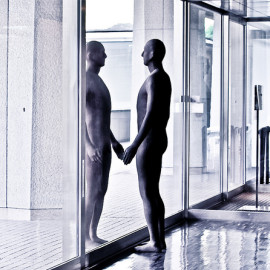The New York Times is reporting on a ban of advertisements that promote unhealthy body images in the London public transportation system. The ban reminded me of another article I read on the PTDC that asked the question “is training for a competition just a socially acceptable way to indulge in obsessive behaviours and disordered eating habits?” I applaud this discussion because after five years as a personal trainer, I am convinced that body image is one of the most counter-productive forces in our quest to be healthier, fitter people.
The majority of people who come into a gym want to change their appearance. Yes, they also recognize that there are health benefits, and sometimes health necessities, that are important but most people want to see their bodies change. Most people also judge their level of success based on whether or not they have lost weight and/or if they have gained muscle. The bottom line is, the overwhelming majority of people are unhappy with their bodies aesthetically and they want them to change.
Change Habits, Not Bodies
A better way would be not to focus on how our appearance should change, but rather, how our habits should change. What we really want to do is say to ourselves: I’d like to alter my habits towards eating healthier, being more active, stressing less, sleeping more, and being a more healthy and fit version of myself – or any other habit goals might be important to you. By asking yourself what changes in your lifestyle you are willing to make and by creating a plan to actually implement them, you can steer yourself towards success. Finally, if you are successful in creating new habits and a new lifestyle for yourself, your body will change into whatever aesthetic is realistic for your new level of health.
The reason that this is such a better approach is that it can be impossible to know if a certain body image is even achievable for you and if so, how much input is really going to be required to get there. This can lead to a downward spiral of obsessive and disordered behavior. When it is all about achieving a certain image, suddenly every possible method is open to consideration and indeed even seems to be necessary. What’s worse, for those who do not have the time to put in huge numbers of hours and effort into the quest (because they are not professional models, body builders, etc.), shortcuts become very attractive. The majority of these can be relatively benign, mostly wasting money, but others can be very destructive.
Conclusion
In short, both of these articles are examples of extremes, but the underlying issue they address is completely common. The focus on body image isn’t helping us become a healthier or happier society. So, I’d like to recommend to everyone that they ask themselves not who or what they should look like, but rather, what changes in their habits and lifestyles they can make towards being healthier and fitter.
RELATED:
Stigma and the Obesity Paradox
PHOTO:
KittyKaht, Mirrored, License
ARTICLES CITED:
London Mayor Cracks Down on Ads Promoting Unhealthy Body Image
Disordered Eating and the Rise of the Competitive Fitness Model

Thanks for reminding us of what a balanced attitude toward fitness is like. One advantage of being older is that one’s body image is not as crucial! See song from the movie musical Gigi by Lerner and Loewe “I’m Glad I’m Not Young Anymore”. But keeping fit may be more important as we age. And very interesting Times article you linked to re London mayor banning ads on public trans picturing super thin models. Says also, “ the French Parliament approved measures aimed at preventing modeling agencies from hiring models deemed dangerously thin.” Interesting that France, Israel, Italy and Spain enacted similar laws. Repeated ads or pics of ultra thin models can influence people unconsciously. Ads exaggerate to attract attention. It’s reasonable to regulate ads aimed at ‘captive audiences’ in public spaces and on transport (as the Times cites) more than to regulate ads in publications or TV that people can choose or not.
Pingback: Body Image Doublethink - do the movement October 26, 2016
[…] Focus On Habits, Not Body Image […]